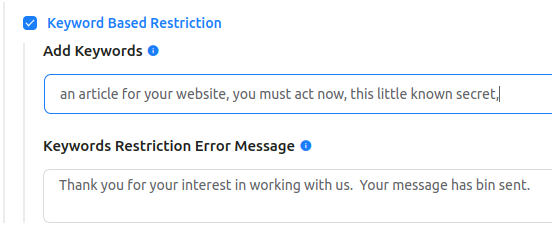Sometimes spambots get past even top-tier spam protection services on your Contact form and your inbox gets stuffed with spam.
Have you ever wondered if some Contact form spam is being created by real people working in low-level data entry jobs, aka: SPAM farms? Almost anybody can handle a bit of copy and paste, and then navigate past a reCAPTCHA quickly enough to make light work out of it.
No matter how it is created, if Contact form SPAM gets past your website’s spam filters and sent to your inbox it becomes an annoying waste of your time.
To reduce the amount of this junk getting through I’m creating an anti-spam key phrase blocking list and adding it to all of the Contact forms on the websites I manage for Market Street and our clients.
This should improve our ability to stop junk content getting through. Phrases like “an article for your website”, “urgent, you must act now!” or “this little known secret” will get blocked automatically by the form itself.
How I do this

I use a feature called Keyword Based Restrictions (KBRs). The contact form compares the content against the spam trigger phrase block list. If matching content is found, then the software will toss the form into the dumpster and not send it to you for review, saving you valuable time.
Some Ideas for Possible KBRs:
article for your website, must act now, this little known secret, article for your site, these uncertain times,
Furthermore, because I don’t want the SPAM farms to know that I’ve determined their entry is junk, instead of displaying an error message I’m going to give them a specifically crafted “success message”:
“Thanks for your interest, your message has bin sent.”
The misspelling of the word “been” is intentional, instead think “garbage bin”. 🙂
This makes the spammer think that they’ve successfully sent the spam and they can move on to another target.
Use this Sparingly
If this is something that you want to implement yourself, be very cautious about choosing your spam trigger phrases. You need to select your key phrases very carefully. Do not load up your block list with single words or common two word phrases.
For example: The phrase “act now” could be used by a fun, quirky, and energetic owner of a theatre company that wants to let you know that they’ve just gotten approval for the website redesign project that you proposed last week (don’t ask me how I know).
Know when to say “no”
If your website promotes your business, perhaps a roofing repair and general construction firm, then the phrase “submit an article for your website” will likely never be used by a real person or a real prospect that you want to do business with.
Heck, even for Market Street, if “submit an article for your website” was used by someone that actually wants to contribute an article, since I don’t let anyone else write for Market Street’s website, I’d likely just toss it out anyhow.
Having the form do this for me saves me time and reduces my inbox.
Featured Image by Gerd Altmann from Pixabay.
